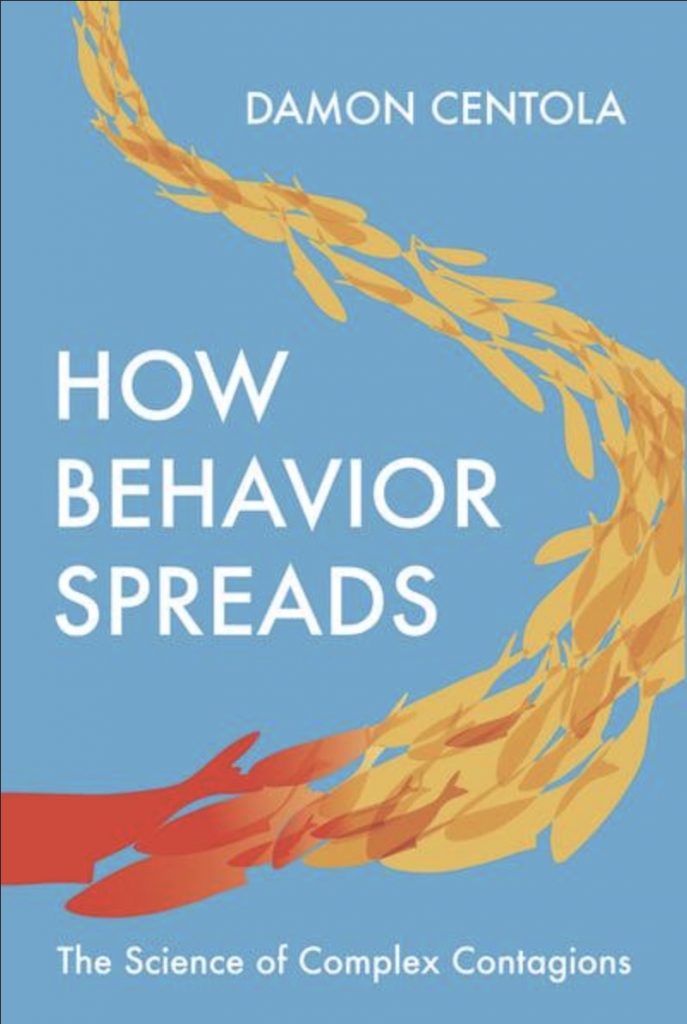Key Quote: “While it may not always be possible to alter behaviors to make them more attractive, it is often possible to identify and target social pathways that can increase the legitimacy and adoption of social change” (p. 15).
Key Concepts:
Introduction. Social and peer-to-peer influence is more effective in bringing about social change than top-down directives or shaming.
Understanding Diffusion. Time and again, social scientists see that the structure of social networks “can be used to impede, or accelerate, the spread of behaviors” (p. 15). Strong social ties are more trusted and influential within a group, but when ideas and behaviors leap between people with weak social ties, they are spread farther and more broadly.
The Theory of Complex Contagions. Complex ideas or behaviors are “costly” and require “financial, psychological, or reputational” risk in order to be adopted, and so they require multiple social contacts for infectious spread (p. 36).
A Social Experiment on the Internet. “Redundancy” (multiple sources of behavior reinforcement) is key to affecting not just local (or “clustered”) but widespread behavioral change. Local commitment also serves to maintain challenging new behaviors.
Complex Contagions in Other Contexts. Lower risk actions and behaviors spread easily through weak ties, and even more so if there is a social benefit to involvement. Higher risk/high-cost activities (e.g. protesting oppression under a despotic regime) depend heavily on committed sharing in strong-tie groups with connections to each other, such as churches, activist circles, and hometown groups.
Diffusing Innovations That Face Opposition. Some settled groups can undermine innovative new ideas or behaviors, and in these cases a strategic approach is necessary. “Incubator neighborhoods” – groups where a new idea is safely tested and spread – can help develop new products or ideas and build support before they are launched more widely.
Diffusing Change in Organizations. Key brokers (trusted people who people can bridge gaps between tight groups) and “wide bridges” (multiple human connection points between a few people within groups) can also help innovation jump from group to group. Within organizations, “balanced organizational identities create organizational networks that act as a filter for testing innovative ideas” (p. 133). Once an idea gains traction with various groups that overlap, strategies can be developed to help spread the innovation outward.
Designing Social Networks for Diffusion. In addition to creating wide bridges, other features can help complex contagions spread. “Social selection” (finding a group where you share similar experiences and views with others) is a key first step to developing highly relevant and influential social connections.
Creating Social Context for Behavior Change. Depending on how they are implemented, social networks may either spark a positive networking dynamic or they may increase complacency. One or two small changes in approach can make the difference between a highly successful social network and a poorly performing one.
Conclusion. Effectively spreading behavior is less difficult than we imagine it to be. For social diffusion, “the minimal requirement is only that individuals are embedded in social networks that provide them with relevant sources of information” (p. 173).
Diffusion
Ideas and human interactions spread throughout a population, similar to how pathogens spread an infectious disease. Both can be understood through the lens of diffusion (p. 14), which is the spreading of disease or, in this case, behavior.
Infectious disease pathogens that are highly contagious spread from person to person with a single contact point, such as a sneeze. Other less infectious pathogens take longer to spread because they require a much higher contact volume to infect someone. We can look at these two infectious disease models as a proxy for understanding how ideas and behaviors spread based on the effort needed to adopt them (p. 37).
Ideas that spread quickly through one contact or conversation to another are simple contagions. Ideas that take longer to spread and require many people to reinforce the idea are complex contagions. Complex contagions are defined as “requiring contact with multiple sources of reinforcement in order to be transmitted” (p. 37).
Unlike simple contagions, a complex idea or behavior, such as lifestyle advice, requires more information to be given multiple times to make an impact on someone. Therefore, it takes significantly longer for something of that nature to diffuse within a population.
Objective facts diffuse easily in a population, much like the common cold does. If one person tells a group of people the LA Lakers game score, everyone within the vicinity can spread that information immediately (p. 83).
Diffusion Between Strong and Weak Ties
Our social universes can be divided into two types of relationships: strong ties, which can be understood as close relationships such as family and friends, and weak ties, which are acquaintances with whom you interact less frequently and have a lesser investment (p. 6).
Ideas are frequently exchanged within insular, strong-tie networks. However, they rarely expand beyond those networks, because the overlap in each group means that the same people spread things back to each other internally.
Ideas that are spread through weak-tie networks have a significantly larger breadth of impact, given the diversity of each person’s network.
“Strong ties tend to be structurally clustered,” as they are bound within the tight community. However, “weak ties are structurally long.” They have a broader spread but require more work to take hold. A person’s strong-tie group tends to co-mingle insularly and not with other people, whereas weak ties are dispersed through a larger social universe (p. 174).
Identifying people in a weak-tie network who are willing to adopt and advocate for adoption is the most effective method of diffusion.
Diffusion of Ideas in a Population
Ideas spread successfully based on four principles:
- Legitimacy: “The more people who adopt a behavior, the greater the expectation is that other people will approve of the decision to adopt and the lower the risk of embarrassment or sanction” (p. 39).
- Credibility: “The more people who adopt a behavior, the more believable it is that the behavior is beneficial or worth the cost of adoption” (p. 38).
- Strategic complementarity: “The value of a behavior increases with the number of others who adopt it” (p. 38).
- Emotional contagion: “The excitement associated with adopting a behavior increases with the number of others who adopt it” (p. 39).
Adoption depends on the perceived value of an idea, at the most basic level. Value is attributed to the number of people who have adopted it (p. 46). The less familiar an innovation is to people – the more inconvenient, uncomfortable, or expensive – the greater the resistance will typically be, and the less likely it will diffuse (p. 14).
Something will not spread if it is confined to someone’s strong-tie network. In fact, “a diffusion process that fails to exploit weak ties, and therefore limits its own exposure to the population, is likely to eliminate its own best chances of success” (p. 32).
Complex or disruptive ideas are spread through the power of numbers. “Particularly when a social movement is risky or dangerous, and most people are initially unlikely to join, large-scale mobilization depends upon recruitment networks that can activate weak ties that will increase the movement’s exposure to the population” (p. 30).
People are very selective about the connections that they make, and research shows that these links are highly influential. The takeaway is, “the factors that determine how people choose their network ties are also the factors that determine who influences their behavior” (p. 148).
Diffusion of Ideas Within an Organization
Brokers create bridges and bridges are what spread ideas through an organization. A broker is someone who serves as a connector between two groups. “Without brokers, information would fail to diffuse, and opportunities for collaboration, exchange, and innovation would be lost.” Bridges that connect structural holes play a vital role in facilitating innovation diffusion within organizations (p. 110).
Behavior is spread by a broker between two groups when “both sides know that [they are] the unique link between two disconnected groups. This may not have any consequences for simple information diffusion, but for the spread of a new business practice or a costly innovation, the sincerity and trustworthiness of the messenger may be just as important as the message” (p. 117).
Well-connected people within an organization bridge the gap between numerous subnetworks and serve as dispersion hubs. When they spread one idea between two groups, they create a common connection.
Wide bridges are people who have the ability to broker relationships between multiple individuals who have parallel ties with each other. Their existence is a hallmark of a stable and durable organizational structure. “The wider the bridges are between organizations, the more reliable and enduring these relationships are likely to be, and the more influence they are likely to have over each other’s business culture, norms of conduct, and the adoption of innovative practices” (p. 118).
During change, identifying bridges and ensuring they buy into the initiative will place you in the best position for success, given their ability to disseminate information to receptive audiences.

“While it may not always be possible to alter behaviors to make them more attractive, it is often possible to identify and target social pathways that can increase the legitimacy and adoption of social change” (p. 15).
Centola, D. (2020). How Behavior Spreads: The Science of Complex Contagions. Princeton University Press.
